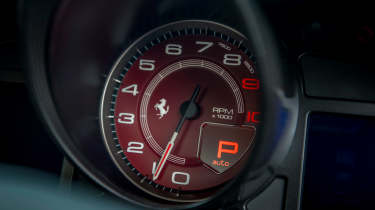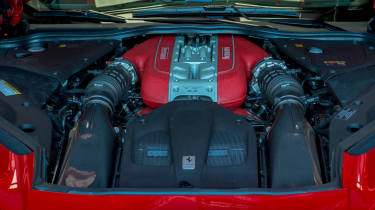Ferrari 812 Superfast review – engine, transmission and technical details
The pinnacle of front-engined Ferrari engineering, the 812 melds mind-warping performance with a chassis that draws you into the action
The Superfast’s 6496cc V12 was 75 per cent new. It’s essentially the F12’s 6.2-litre V12 but with a longer 78mm stroke that stretches capacity, plus a compression ratio of, deep breath, 13.64:1. As a result of this, plus numerous other internal upgrades – predominantly to the intake system to maximise the efficiency of the combustion process and help it breathe better – the V12 produced 789bhp at 8500rpm, 529lb ft at 7000rpm (with 80 per cent of this available from 3500rpm), revving to a quite magnificent 8900rpm before the limiter intrudes.
The power and torque curves in the 812 are more full-bodied than the F12. Torque is stronger from the word go and builds to a crescendo until the rev limiter comes into play, pretty much mirroring the power curve. Power is delivered to the rear wheels via the familiar seven-speed dual-clutch gearbox, which has been tweaked with shorter gear ratios and shifts that are 30 per cent faster on the way up the ‘box, and 40 per cent quicker on the way down. The electronically controlled rear differential also incorporates the F1-TRAC technology and the fifth iteration of the brand’s Slide Slip Control.
The exhaust features a six into one manifold that is, again, a fair bit more efficient than the system used in the F12, says Ferrari, allowing the engine to breathe better both in and out. And the sound it allows the V12 to emit over the last 3000rpm needs to be experienced to be believed.
Highlights under the skin include an electronic four-wheel-steering system that increases stability everywhere, while dramatically improving turn-in response and eradicating understeer. Called Virtual Short Wheelbase, it’s a development of the somewhat spikier-reacting set-up first seen on the TdF. There’s also an F1-TRAC electronic differential and a fifth-generation version of Ferrari’s side slip control system, which is engaged (or disengaged) via the traditional manettino switch on the steering wheel.
At the front the electric power steering system was revised with variable torque assistance, which sounds a bit weird and indeed is, slightly, to begin with. It’s especially so when you realise that the system is actively designed to help you apply opposite lock when the rear end steps out of line.
The brakes are by Brembo and feature vast 398mm carbon-ceramic discs at the front and almost as big 360mm CC rotors at the rear. Interestingly, the tyres are regular Pirelli P Zeros rather than Corsas, Ferrari justifying this choice on the grounds that it wants the 812 to be perceived as a fully usable road car first, not a full-on track weapon that can merely be tolerated on the road.




